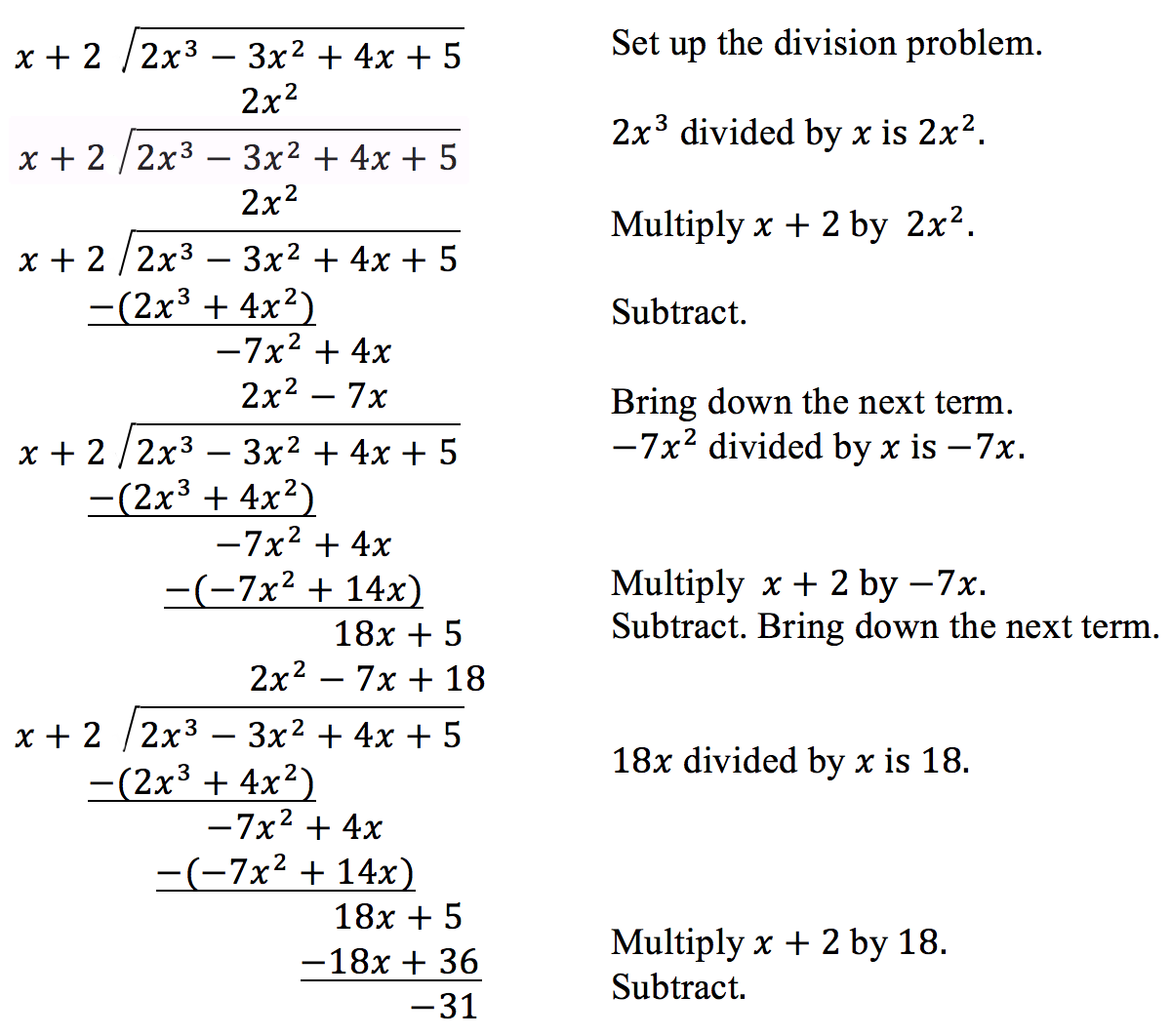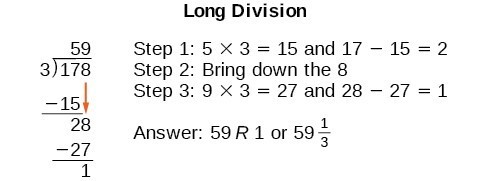Learning Outcomes
- Divide a polynomial by a monomial
- Use long division to divide polynomials
Dividing a Monomial by a Monomial
Consider the example, [latex]\dfrac{x^3}{x^2}[/latex]:
[latex]\begin{aligned}\dfrac{x^3}{x^2}&=\dfrac{x\cdot x\cdot x}{x\cdot x}\\&=\dfrac{\cancel{x} \cdot \cancel{x} \cdot x}{\cancel{x} \cdot \cancel{x}}\\&=\dfrac{1 \cdot 1 \cdot x}{1 \cdot 1}\\&=\dfrac{x}{1}\\&=x\end{aligned}[/latex].
Since, [latex]\dfrac{x}{x}=1,\;x\neq0[/latex], we cancel common factors on the numerator and denominator to 1. Likewise, [latex]\dfrac{x^2}{x^2}=1,\;\dfrac{x^3}{x^3}=1,\;,...\dfrac{x^n}{x^n}=1[/latex], provided that [latex]x\neq0[/latex].
Similarly, for the division [latex]\dfrac{x}{x^2}[/latex],
[latex]\begin{aligned}\dfrac{x}{x^2}&=\dfrac{x}{x\cdot x}\\&=\dfrac{\cancel{x}}{\cancel{x} \cdot x}\\&=\dfrac{1}{1 \cdot x}\\&=\dfrac{1}{x}\end{aligned}[/latex].
In summary, to simplify a fraction where the numerator and denominator have the same base but different exponents, we can cancel out all common factors. This is equivalent to keeping the common base and subtracting the exponents i.e. to divide a monomial by a monomial, we employ the division property of exponents.
The division property of exponents
For all [latex]m,\;n,\; x \in\mathbb{R}[/latex] and [latex]x\neq0[/latex],
[latex]\dfrac{x^m}{x^n}=x^{m-n}[/latex]
Example 1
Simplify:
1. [latex]\dfrac{x^8}{x^3}[/latex]
2. [latex]\dfrac{y^4}{y^4}[/latex]
3. [latex]\dfrac{x^3}{x^7}[/latex]
Solution
1. [latex]\dfrac{x^8}{x^3}=x^{8-3}=x^5[/latex]
2. [latex]\dfrac{y^4}{y^4}=y^{4-4}=y^0=1[/latex] Recall that [latex]y^0=1[/latex] for all [latex]y\neq0[/latex]; [latex]0^0[/latex] is undefined.
3. [latex]\dfrac{x^3}{x^7}=x^{3-7}=x^{-4}=\dfrac{1}{x^4}[/latex] Recall that, [latex]x^{-n}=\dfrac{1}{x^n}[/latex]
If the exponential terms have coefficients other than 1, we divide the coefficients.
Example 2
Simplify:
1. [latex]\dfrac{9x^7}{3x^3}[/latex]
2. [latex]-\dfrac{15y^8}{5y^8}[/latex]
3. [latex]-\dfrac{7x^3}{14x^7}[/latex]
Solution
1. [latex]\dfrac{9x^7}{3x^3}=\dfrac{9}{3}x^{7-3}=3x^4[/latex]
2. [latex]-\dfrac{15y^8}{5y^8}=-\dfrac{15}{5}y^{8-8}=-3y^0=-3\cdot 1=-3[/latex]
3. [latex]-\dfrac{7x^3}{14x^7}-\dfrac{7}{14}x^{3-7}=-\dfrac{1}{2}x^{-4}=-\dfrac{1}{2}\cdot\dfrac{1}{x^4}=-\dfrac{1}{2x^4}[/latex]
Try It 1
1. [latex]\dfrac{x^8}{x^6}[/latex]
2. [latex]\dfrac{20x^{12}}{5x^7}[/latex]
3. [latex]-\dfrac{12y^5}{4y^5}[/latex]
4. [latex]-\dfrac{16x^4}{8x^9}[/latex]
Dividing a Polynomial by a Monomial
The distributive property of multiplication over addition also works for division, since division is just multiplication by the reciprocal.
The distributive property
[latex]a(b+c)=ab+ac[/latex]
[latex]\dfrac{a+b}{c}=\dfrac{1}{c}(a+b)=\dfrac{a}{c}+\dfrac{b}{c}[/latex]
where [latex]a,\;b,[/latex] and [latex]c[/latex] are algebraic terms.
To divide a polynomial by a monomial, we can write the division as a fraction, and then decompose the fraction into the sum of fractions, and then simplify each fraction. For example, to divide the polynomial [latex]3x^3-6x^2+18x-7[/latex] by [latex]2x^2[/latex]:
[latex]\begin{aligned}&\;\;\;\;\,\dfrac{3x^3-6x^2+18x-7}{2x^2} \\ \\&= \dfrac{3x^3}{2x^2}-\dfrac{6x^2}{2x^2}+\dfrac{18x}{2x^2}-\dfrac{7}{2x^2} \\ \\&= \dfrac{3}{2}x-3+\dfrac{9}{x}-\dfrac{7}{2x^2}\end{aligned}[/latex]
Example 3
Divide [latex]12x^4-18x^3+36x^2-24x[/latex] by [latex]-6x^2[/latex].
Solution
Divide each term in the first polynomial by the monomial divisor:
[latex]\begin{aligned}&\;\;\;\;\,\dfrac{12x^4-18x^3+36x^2-24x}{-6x^2}\\ \\&=\dfrac{12x^4}{-6x^2}-\dfrac{18x^3}{-6x^2}+\dfrac{36x^2}{-6x^2}-\dfrac{24x}{-6x^2}\\ \\&=-2x^2+3x-6+\dfrac{4}{x}\end{aligned}[/latex]
Try It 2
Divide [latex]60x^5-30x^4+25x^3-35x+10[/latex] by [latex]10x^3[/latex].
Dividing Polynomials using Long Division
long division revision
When we divide two numbers, we often end up with a remainder. For example, [latex]17\div 3 = 5\;\text{R}(3)[/latex].
This can also be thought of as:
[latex]\dfrac{17}{3}=5+\dfrac{2}{3}[/latex]
Equivalently, multiplying both sides by 3:
[latex]17=3\cdot 5 + 2[/latex]
The process used to accomplish division of polynomials is similar to long division of whole numbers, so it is essential that we are confident with long division of whole numbers. If you haven’t performed long division for a while, take a moment to refresh before reading this section.
Example 4
Use long division to divide: [latex]\dfrac{242}{15}[/latex]
Solution
[latex]\begin{aligned}16\\15) \overline{242}\\15\;\;\\ \overline{92}\\ 90\\ \overline{2}\end{aligned}[/latex]
So, [latex]\dfrac{242}{15}=16 +\dfrac{2}{15}[/latex]
Equivalently, [latex]242=15\cdot 16 + 2[/latex]
Try It 3
Use long division to divide: [latex]\dfrac{463}{12}[/latex]
[latex]\dfrac{463}{12}=38+\dfrac{7}{12}[/latex]
The Division Algorithm
The division algorithm for arithmetic can be adapted to polynomials.
division algorithm for polynomials
Let [latex]p(x)[/latex] and [latex]d(x)[/latex] be polynomials where the degree of [latex]p(x)[/latex] ≥ the degree of [latex]d(x)[/latex], then
[latex]\dfrac{p(x)}{d(x)}=q(x)+\dfrac{r(x)}{d(x)}[/latex]
where the degree of [latex]r(x)[/latex] < the degree of [latex]d(x)[/latex].
Equivalently, multiplying both sides by [latex]d(x)[/latex]:
[latex]p(x)=d(x)q(x) + r(x)[/latex]
The division algorithm allows us to divide two polynomials. To set up this division there are two basic rules that must be adhered to:
- The polynomials of the divisor and dividend need to be in descending order, which means the terms of a polynomial are written in the order of descending powers of variables.
- There should be no gaps in the descending order of powers. Any gaps need to be filled with zeros.
For example, if the dividend is given as [latex]4+5x-3x^3[/latex], the first step tells us to write the polynomial in descending order:
[latex]-3x^3+5x+4[/latex]
Since there is no [latex]x^2[/latex] term in this polynomial (i.e. there is a gap), we must include [latex]0x^2[/latex] as a term to fill the gap:
[latex]-3x^3\color{blue}{+0x^2}+5x+4[/latex]
Example 5
Write the polynomial in descending order, filling any gaps with zeros.
1. [latex]7x^3-8+2x^2[/latex]
2. [latex]6x-4x^2-3x^3+x^5[/latex]
Solution
1. First write [latex]7x^3-8+2x^2[/latex] in descending order: [latex]7x^3+2x^2-8[/latex]
Now look for missing terms: there is no [latex]x[/latex] term. Write [latex]0x[/latex] where the [latex]x[/latex] term should be:
[latex]7x^3+2x^2\color{blue}{+0x}-8[/latex]
2. First write [latex]6x-4x^2-3x^3+x^5[/latex] in descending order: [latex]x^5-3x^3-4x^2+6x[/latex]
Now look for missing terms: there is no [latex]x^4[/latex] term and no constant term. Write [latex]0x^4[/latex] where the [latex]x^4[/latex] term should be, and write 0 for the constant term at the end of the polynomial:
[latex]x^5\color{blue}{+0x^4}-3x^3-4x^2+6x\color{blue}{+0}[/latex]
Try It 4
Write the polynomial in descending order, filling any gaps with zeros.
1. [latex]7x^4-8x+2x^2[/latex]
2. [latex]-2x-4x^4-3x^3+x^5[/latex]
The process for dividing polynomials is basically the same as it was for whole numbers.
| As an example, let’s divide [latex]x^2+x+1[/latex] by [latex]x-1[/latex].
We truncate the divisor [latex]x-1[/latex] to [latex]x[/latex] and divide the first term in the dividend by [latex]x[/latex]: [latex]\dfrac{x^2}{x}=x[/latex]. This [latex]\color{blue}{x}[/latex] goes on the quotient line. Now multiply [latex]\color{blue}{x}[/latex] by the divisor [latex]x-1[/latex]: [latex]\color{blue}{x}\cdot(x-1)=\color{blue}{x^2-x}[/latex]. This goes under the dividend. Now subtract: [latex](x^2+x+1)-(\color{blue}{x^2-x})=(x^2-x^2)+(x-(-x))+1=\color{red}{2x+1}[/latex]. Divide [latex]2x[/latex] by [latex]x[/latex]: [latex]\dfrac{2x}{x}=\color{green}{2}[/latex]. Add this [latex]\color{green}{2}[/latex] onto the quotient line. Multiply [latex]\color{green}{2}[/latex] by the divisor [latex]x-1[/latex]: [latex]\color{green}{2}(x-1)=\color{green}{2x-2}[/latex]. FInally, subtract: [latex]\color{red}{(2x+1)}-\color{green}{(2x-2)}=(\color{red}{2x}-\color{green}{2x})+(\color{red}{1}-(\color{green}{-2}))=\color{orange}{3}[/latex]. We have found that [latex]\dfrac{x^2+x+1}{x-1}=x+2+\dfrac{3}{x-1}[/latex]. |
[latex]\begin{aligned}\color{blue}{x}+\color{green}{2}\\x-1 )\overline{x^2+x+1}\\ \color{blue}{x^2-x}\;\;\;\;\;\;\\ \overline{\color{red}{2x+1}}\\\underline{\color{green}{2x-2}}\\ \color{orange}{3}\end{aligned}[/latex] |
We can identify the dividend, divisor, quotient, and remainder by writing this answer in its equivalent form:
[latex]\begin{array}{lllllll}&x^2+x+1&=&(x-1)&(x+2)&+&3\\&\text{Dividend}&&\text{Divisor}&\text{Quotient}&&\text{Remainder}\end{array}[/latex]
Example 6
Divide [latex]2{x}^{3}-3{x}^{2}+4x+5[/latex] by [latex]x+2[/latex] using the long division algorithm.
Solution

Answer
[latex]\dfrac{2{x}^{3}-3{x}^{2}+4x+5}{x+2}=2{x}^{2}-7x+18+\dfrac{-31}{x+2}[/latex]
or equivalently,
[latex]2{x}^{3}-3{x}^{2}+4x+5=\left(x+2\right)\left(2{x}^{2}-7x+18\right)+(-31)[/latex]
We can identify the dividend, divisor, quotient, and remainder.

Notice that the remainder in this example is negative. Even when the remainder is negative, we add it as a negative remainder.
using long division to divide polynomials
- Set up the division problem based on the rules of descending powers and no gaps.
- Determine the first term of the quotient by dividing the leading term of the dividend by the leading term of the divisor.
- Put the answer as the first term in the quotient.
- Multiply the answer by the divisor and write it below the like terms of the dividend.
- Subtract the product in step 4 from all the terms above it.
- Repeat steps 2–5 until reaching the last term of the dividend.
- If the remainder is non-zero, express as a fraction using the divisor as the denominator.
Example 7
Divide [latex]5{x}^{2}+3x - 2[/latex] by [latex]x+1[/latex].
Solution

The quotient is [latex]5x - 2[/latex]. The remainder is 0. We write the result as:
[latex]\dfrac{5{x}^{2}+3x - 2}{x+1}=5x - 2[/latex]
Analysis of the Solution
This division problem had a remainder of 0. This tells us that the dividend is divided exactly by the divisor and that, therefore, the divisor and the quotient are factors of the dividend. [latex]5{x}^{2}+3x - 2=\left(x+1\right)\left(5x - 2\right)[/latex]
Example 8
Divide [latex]6{x}^{3}+11{x}^{2}-31x+15[/latex] by [latex]3x - 2[/latex].
Solution
There is a remainder of 1. We can express the result as:
[latex]\dfrac{6{x}^{3}+11{x}^{2}-31x+15}{3x - 2}=2{x}^{2}+5x - 7+\dfrac{1}{3x - 2}[/latex]
Analysis of the Solution
We can check our work by using the Division Algorithm to rewrite the solution then multiplying.
[latex]\;\;\;\left(3x - 2\right)\left(2{x}^{2}+5x - 7\right)+1\\=3x\left(2{x}^{2}+5x - 7\right)-2\left(2{x}^{2}+5x - 7\right)+1\\=6x^3+15x^2-21x-4x^2-10x+14+1\\=6{x}^{3}+11{x}^{2}-31x+15[/latex]
Notice, as we write our result,
- the dividend is [latex]6{x}^{3}+11{x}^{2}-31x+15[/latex]
- the divisor is [latex]3x - 2[/latex]
- the quotient is [latex]2{x}^{2}+5x - 7[/latex]
- the remainder is 1
Try It 5
Divide [latex]16{x}^{3}-12{x}^{2}+20x - 3[/latex] by [latex]4x+5[/latex].
Candela Citations
- Two Rules for Setting Up a Long Division. Authored by: Leo Chang and Hazel McKenna. Provided by: Utah Valley University. License: CC BY: Attribution
- Revision and Adaptation. Authored by: Hazel McKenna. Provided by: Lumen Learning. License: CC BY: Attribution
- Divide a Polynomial by a Monomial. Authored by: Leo Chang and Hazel McKenna. Provided by: Utah Valley University. License: CC BY: Attribution
- Division algorithm for polynomials; Examples and Try Its: hjm202, hjm871; hjm761; hjm096. Authored by: Hazel McKenna. Provided by: Utah Valley University. License: CC BY: Attribution
- Question ID 29482. Authored by: McClure,Caren. License: Other. License Terms: IMathAS Community License CC-BY + GPL
- College Algebra. Authored by: Abramson, Jay et al.. Provided by: OpenStax. Located at: http://cnx.org/contents/9b08c294-057f-4201-9f48-5d6ad992740d@5.2. License: CC BY: Attribution. License Terms: Download for free at http://cnx.org/contents/9b08c294-057f-4201-9f48-5d6ad992740d@5.2
- Unit 11: Exponents and Polynomials, from Developmental Math: An Open Program.. Provided by: Monterey Institute of Technology and Education. Located at: http://nrocnetwork.org/dm-opentext.%20. License: CC BY: Attribution


